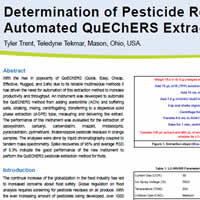Resumo do Pôster:
1. Introduction
The continual increase of the globalization in the food industry has led to increased concerns about food safety. Global regulation on food analysis requires screening for pesticide residues on all produce. With the ever increasing amount of pesticides being developed, over 1000 pesticides must be monitored in a wide range of commodities. With the increasing amount of samples required for analysis, the preferred extraction is the QuEChERS method.1-2
Even though QuEChERS is a simplified extraction technique, it still requires many manual steps including addition of solvent, extraction salts, centrifugation, shaking, decanting and performing the dSPE cleanup. To modernize the traditional QuEChERS extraction an automatic instrument was developed to automate the two part of the method from the liquid extraction through the cleanup. In this work, this automatic instrument was evaluated for the extraction of pesticides in orange samples.
2. Purpose
Validate the performance of the automatic instrument to extract pesticide residues in oranges by the QuEChERS method.
3. Method
Orange samples were prepared according to the procedure described in the AOAC Official Method 20071. The processed samples were frozen until extraction. Figure 1 shows the steps followed to extract pesticide residues from oranges. For this analysis, 7.5 g of AOAC QuEChERS extraction salts (MgSO4 and NaOAc), and 1200.0 mg of MgSO4 plus 400.0 mg of PSA for the dSPE cleanup step were used.
Sample analysis was conducted using a HPLC system coupled to a tandem mass spectrometer (MS/MS) via electrospray ionization (ESI). The target analytes were: azoxystrobin, carbaryl, carbendazim, imazalil, imidacloprid, pyraclostrobin, pyrimethanil, thiabendazole. For separation of these analytes a biphenyl (50 x 2.1 mm, 2.6 µm) column was used. The LC Parameters are presented in Table 1.
Quantification was based on matrix-matched calibration curves with the use of internal standard triphenylphosphate to ensure method accuracy. Quality control samples were evaluated at levels of 10.0, 20.0 and 60.0 μg/Kg to ensure precision and accuracy of the new instrument.
Table 1. LC Parameters |
Mobile Phase |
A: 5 mM ammonium formate in water
B: 5 mM ammonium formate in methanol |
Gradient |
Time |
%B |
0.10 |
5 |
8.00 |
90 |
10.00 |
90 |
10.10 |
5 |
12.1 |
Stop |
Flow Rate (mL/min) |
0.5 |
Column Temperature (°C) |
40 |
4. Results and Discussion
A precision and accuracy study was performed. A 6.0 μg/mL stock pesticide solution was used to fortify the orange samples. QC samples were fortified at 10.0 20.0 and 60.0 μg/Kg using the instrument's ability to make standard additions. The instrument was also used to spike 75.0 μL of the internal standard triphenylphosphate in each sample. These QC samples were quantitated against their corresponding matrix matched calibration curve.
The average recovery ranged from 77.4% to 102.1%. These spike recoveries fall well within the recommended mean values in Document N? Sanco/12495/20113 which states the mean recoveries must fall within 70% to 120% and a RSD <20%. The instrument, also, demonstrated great precision with RSD ranging from 1.8% to 9.6% for the spiked QC samples.
5. Conclusion
The automatic instrument successfully processes orange samples for pesticide residue utilizing the QuEChERS method. The extraction process was faster, more reliable, and easier than the traditional manual based procedure. The combined pesticide spike recoveries of 95.0%, at an average RSD of 5.3%, exceed the requirement outlined in the Document N? Sanco/12495/2011, validating the performance of the new instrument to perform the QuEChERS pesticide extraction method for fruits.
6. References
- AOAC Official Method 2007.07 Pesticide Residues in Food by Acetonitrile Extraction and Partitioning with Magnesium Sulfate. Gas Chromatography/Mass Spectrometry and Liquid Chromatography/Tandem Mass Spectrometry, First Action 2007.
- European Committee for Standardization/Technical Committee CEN/TC275 (2008), Foods of plant origin: Determination of pesticide residues using GC-MS and/or LC-MS/MS following acetonitrile extraction/ partitioning and cleanup by dispersive SPE QuEChERS-method.
- Method Validation and Quality Control Procedure for Pesticide Residues Analysis in Food and Feed (Document N? SANCO/12495/2011).
|

